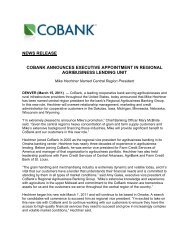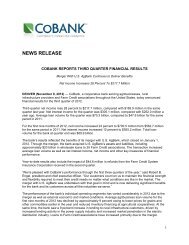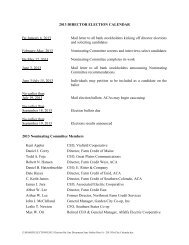Annual Report - CoBank
Annual Report - CoBank
Annual Report - CoBank
- No tags were found...
You also want an ePaper? Increase the reach of your titles
YUMPU automatically turns print PDFs into web optimized ePapers that Google loves.
Prior to purchase, we assess the credit quality of theunderlying pools of mortgages, which is typically enhancedthrough our senior position in receiving cash flows,overcollateralization, excess spreads or through insuranceprovided by third-party bond insurance companies.Deterioration in the financial condition of certain bondinsurance companies, coupled with current issues in theresidential mortgage market, have increased the credit risk inthis sector of our investment portfolio, requiring us to recordimpairment losses on certain securities. The credit quality ofour investment portfolio as of December 31, 2009 and creditloss impairments recorded during 2009 are more fullydiscussed in “Liquidity and Capital Resources” beginning onpage 50.Our counterparty credit risk arising from derivativetransactions is managed within credit methodologies and limitsapproved by the CLC. Managing counterparty exposure ismore fully discussed in “Counterparty Exposure” beginningon page 46.Interest Rate Risk ManagementWe are subject to interest rate risk, which is defined as therisk of changes to future earnings or long-term market valueof equity due to changes in interest rates. This risk primarilyarises from our equity positioning and differences in thetiming between the contractual maturities, repricingcharacteristics, and prepayments of our assets and thefinancing obtained to fund these assets. This risk can also arisefrom embedded caps in certain of our investments anddifferences between the interest rate indices used to price andfund our assets. Our asset/liability management objective is tomanage the mix of interest-earning assets and interest-bearingliabilities to moderate interest rate risk and stabilize our netinterest income while enhancing profitability and insulatingshareholders’ equity from significant adverse fluctuations inmarket interest rates. While we actively manage our interestrate risk position within policy limits approved by the Boardof Directors using strategies established by our ALCO, therecan be no assurance that changes in interest rates will notadversely impact our earnings and capital.The following is a more detailed description of ourprimary interest rate risks and strategies used to mitigate thoserisks.Equity Positioning RiskThe existence of shareholders’ equity that serves as asource of funding for the balance sheet requires us to makedecisions about the maturity mix of the assets funded by thisequity. Using equity to fund short-term assets results inincreased volatility of net interest income, whereas usingequity to fund long-term assets results in increased volatility inthe market value of our equity. We choose to use this equity tofund intermediate-term assets (generally, maturing equally overfive years) to balance the risks to net interest income andmarket value of equity. We anticipate that interest rates arelikely to rise and, as a result, during 2010 we intend to beginshortening the maturities of our equity positioning assets sothat they mature equally over three years.Repricing RiskOccasionally, mismatches in interest rate repricing ofassets and liabilities arise from the interaction of customerbusiness needs, our investment portfolio and liabilitymanagement activities. Exposure to changes in the level anddirection of interest rates is managed by adjusting theasset/liability mix through the use of various interest rate riskmanagement tools, including derivatives. Refer to pages 45and 46 for additional information related to derivatives.Prepayment/Extension RiskPrepayment risk in our loan portfolio is very limited asapproximately 95 percent of our fixed-rate loans contain, at aminimum, make-whole prepayment penalties. Theseprovisions require a borrower to compensate us for the costwe absorb in retiring debt funding associated with theprepayment of loans. This allows us to generally match-fundall of our loan assets and reduces the need to use callable debtto manage the risk of prepayments in the loan portfolio.Prepayment risk in the investment portfolio results whenlong-term interest rates fall and prepayments increase asunderlying borrowers refinance their mortgages to a lowerrate. Prepayments adversely affect investment portfolioincome in a falling interest rate environment becauseinvestments are largely funded with non-callable debt; and anyproceeds from prepaid investments will be reinvested at alower interest rate. Prepayment risk in the investmentportfolio is moderate based on the type and average life ofsecurities we purchase for the portfolio. Purchases ofmortgage-backed securities are currently subject to a price riskeligibility test based on a stressed interest rate environment.The test is designed to manage our exposure to prepaymentrisk at the time of investment purchase. In addition, our fixedratemortgage-backed securities, other than hybrid-ARMS(adjustable-rate mortgage securities), generally contain someembedded prepayment protection in the form of PAC(planned amortization class) bands. These PAC securities arestructured so that principal payments are expected to follow apredetermined schedule as long as the prepayments of theunderlying collateral fall within a prescribed band. Over time,these bands may erode resulting in an incremental increase inprepayment risk within the investment portfolio.We also maintain a liability-sensitive balance sheetposition that provides a partial hedge against investmentprepayments in a falling interest rate environment, which ismore fully discussed on page 44.Extension risk in the investment portfolio occurs whenlong-term interest rates rise and prepayments decrease morethan expected causing the underlying investment securities topay down at a slower rate than initially expected. In thisscenario, investment portfolio income will be negativelyimpacted as additional higher-rate term funding is required tofund extended securities. Extension risk in the investmentportfolio is moderate based on the type and average life ofsecurities purchased. In the same way PAC bands protectagainst prepayment risk, they also serve to limit extension riskas the amortization of these securities is defined as long asprepayments of the underlying collateral fall within aprescribed band.<strong>CoBank</strong> 2009 <strong>Annual</strong> <strong>Report</strong>42













